University Economics Assignment: Inflation, Recession, and Policy
VerifiedAdded on 2023/03/23
|9
|1361
|87
Homework Assignment
AI Summary
This economics assignment delves into several macroeconomic concepts. It begins by defining seigniorage, explaining its implications for government revenue and economic profit, and discussing the Laffer curve's relationship to money growth and inflation control. The assignment then analyzes the aggregate expenditure model, examining the effects of a recession in Europe, rising housing values, interest rate changes, and government expenditure reductions (military base closures). The third part of the assignment explores the Phillips curve, comparing its slope and implications on the relationship between inflation and unemployment. References include relevant economic literature.

Running head: ECONOMICS
Economics
Name of the student
Name of the university
Author note
Economics
Name of the student
Name of the university
Author note
Paraphrase This Document
Need a fresh take? Get an instant paraphrase of this document with our AI Paraphraser
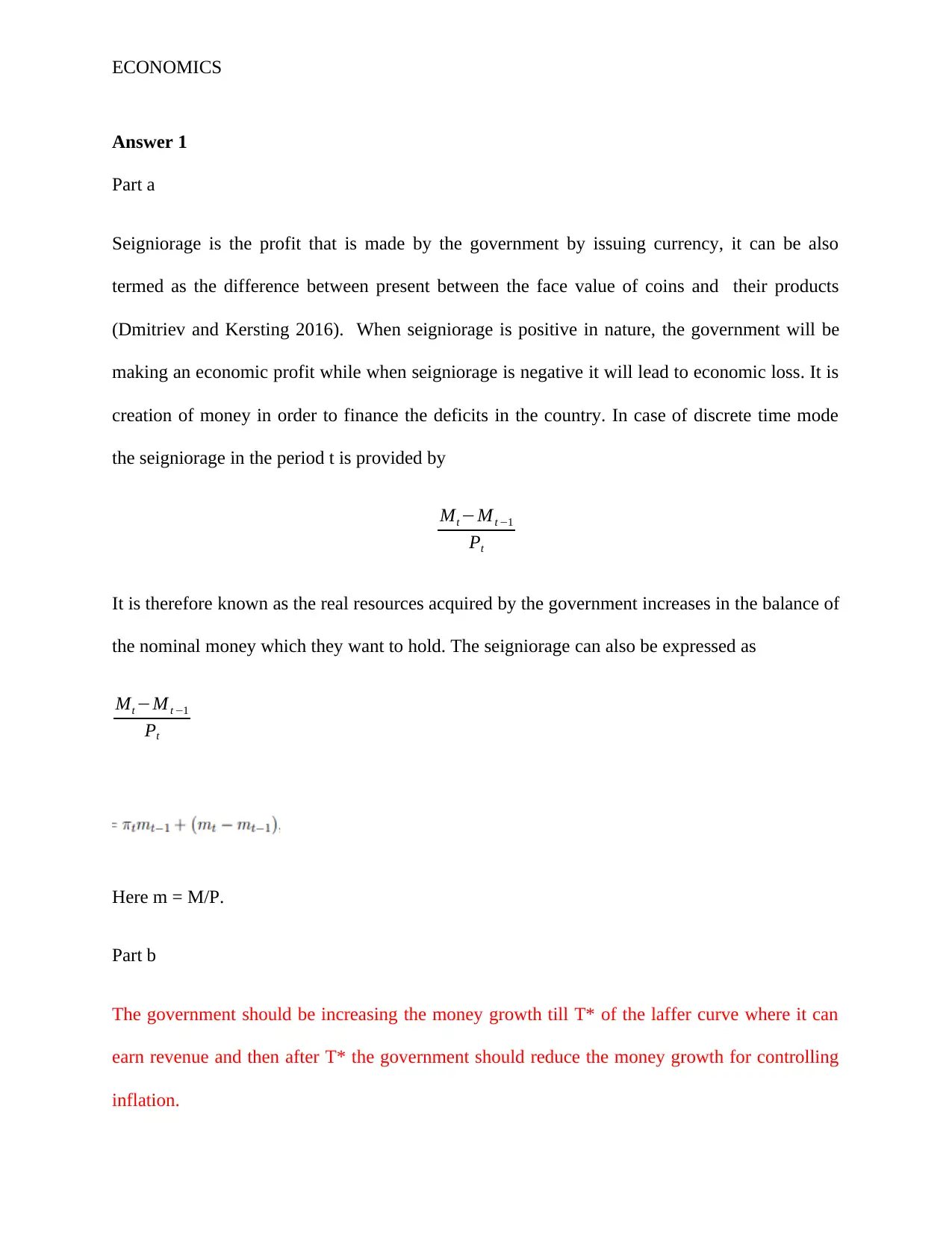
ECONOMICS
Answer 1
Part a
Seigniorage is the profit that is made by the government by issuing currency, it can be also
termed as the difference between present between the face value of coins and their products
(Dmitriev and Kersting 2016). When seigniorage is positive in nature, the government will be
making an economic profit while when seigniorage is negative it will lead to economic loss. It is
creation of money in order to finance the deficits in the country. In case of discrete time mode
the seigniorage in the period t is provided by
Mt −Mt −1
Pt
It is therefore known as the real resources acquired by the government increases in the balance of
the nominal money which they want to hold. The seigniorage can also be expressed as
Mt −M t −1
Pt
Here m = M/P.
Part b
The government should be increasing the money growth till T* of the laffer curve where it can
earn revenue and then after T* the government should reduce the money growth for controlling
inflation.
Answer 1
Part a
Seigniorage is the profit that is made by the government by issuing currency, it can be also
termed as the difference between present between the face value of coins and their products
(Dmitriev and Kersting 2016). When seigniorage is positive in nature, the government will be
making an economic profit while when seigniorage is negative it will lead to economic loss. It is
creation of money in order to finance the deficits in the country. In case of discrete time mode
the seigniorage in the period t is provided by
Mt −Mt −1
Pt
It is therefore known as the real resources acquired by the government increases in the balance of
the nominal money which they want to hold. The seigniorage can also be expressed as
Mt −M t −1
Pt
Here m = M/P.
Part b
The government should be increasing the money growth till T* of the laffer curve where it can
earn revenue and then after T* the government should reduce the money growth for controlling
inflation.
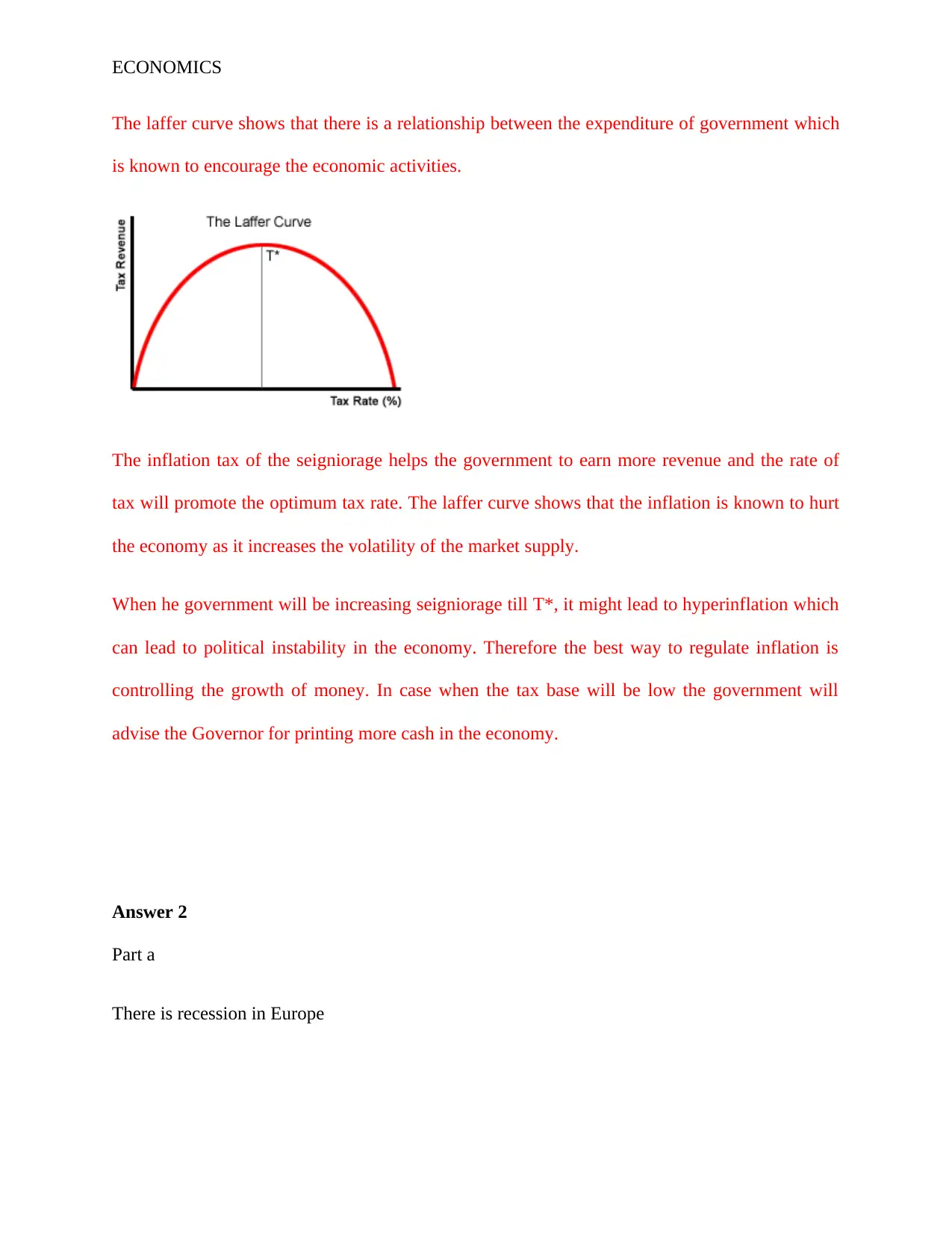
ECONOMICS
The laffer curve shows that there is a relationship between the expenditure of government which
is known to encourage the economic activities.
The inflation tax of the seigniorage helps the government to earn more revenue and the rate of
tax will promote the optimum tax rate. The laffer curve shows that the inflation is known to hurt
the economy as it increases the volatility of the market supply.
When he government will be increasing seigniorage till T*, it might lead to hyperinflation which
can lead to political instability in the economy. Therefore the best way to regulate inflation is
controlling the growth of money. In case when the tax base will be low the government will
advise the Governor for printing more cash in the economy.
Answer 2
Part a
There is recession in Europe
The laffer curve shows that there is a relationship between the expenditure of government which
is known to encourage the economic activities.
The inflation tax of the seigniorage helps the government to earn more revenue and the rate of
tax will promote the optimum tax rate. The laffer curve shows that the inflation is known to hurt
the economy as it increases the volatility of the market supply.
When he government will be increasing seigniorage till T*, it might lead to hyperinflation which
can lead to political instability in the economy. Therefore the best way to regulate inflation is
controlling the growth of money. In case when the tax base will be low the government will
advise the Governor for printing more cash in the economy.
Answer 2
Part a
There is recession in Europe
⊘ This is a preview!⊘
Do you want full access?
Subscribe today to unlock all pages.

Trusted by 1+ million students worldwide
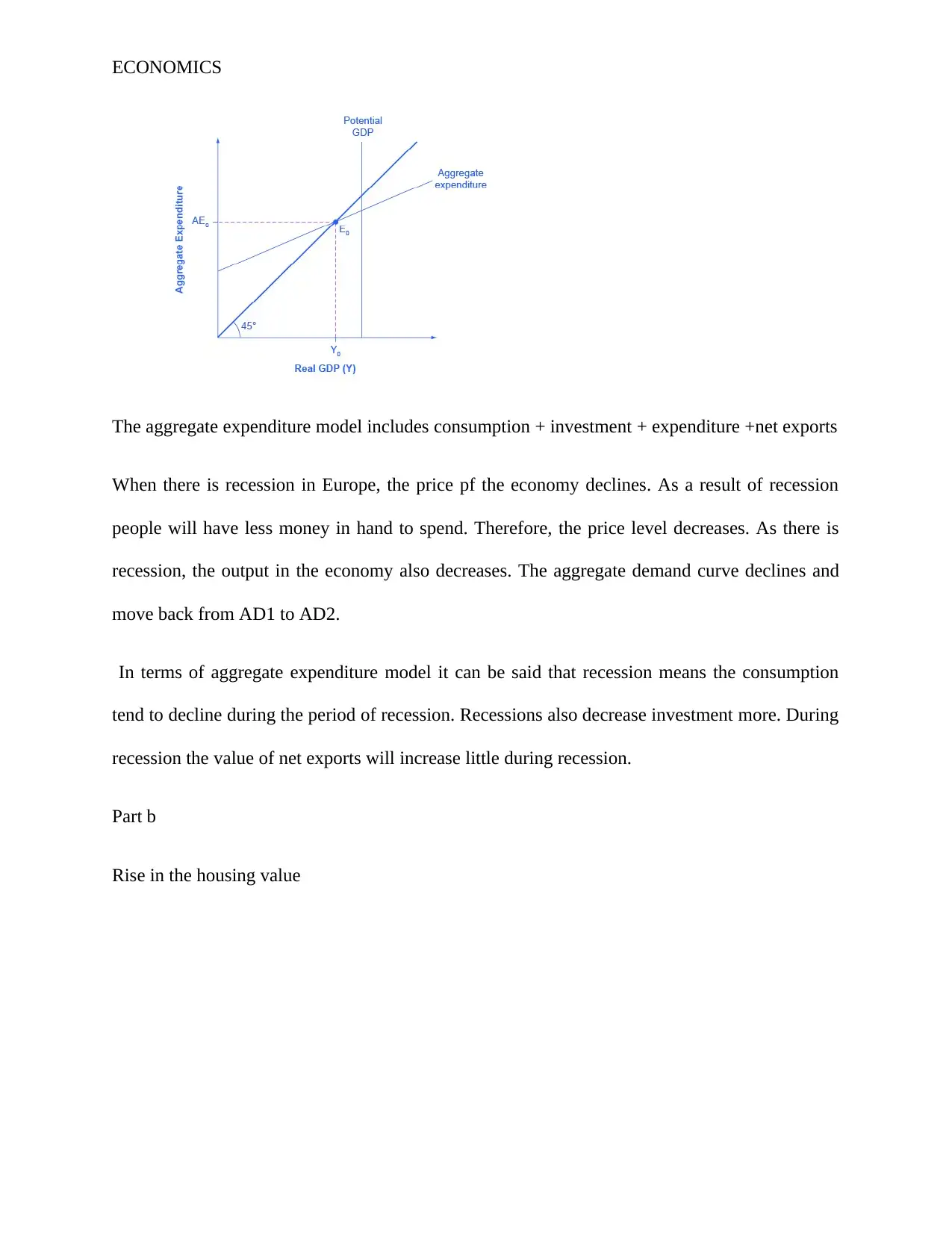
ECONOMICS
The aggregate expenditure model includes consumption + investment + expenditure +net exports
When there is recession in Europe, the price pf the economy declines. As a result of recession
people will have less money in hand to spend. Therefore, the price level decreases. As there is
recession, the output in the economy also decreases. The aggregate demand curve declines and
move back from AD1 to AD2.
In terms of aggregate expenditure model it can be said that recession means the consumption
tend to decline during the period of recession. Recessions also decrease investment more. During
recession the value of net exports will increase little during recession.
Part b
Rise in the housing value
The aggregate expenditure model includes consumption + investment + expenditure +net exports
When there is recession in Europe, the price pf the economy declines. As a result of recession
people will have less money in hand to spend. Therefore, the price level decreases. As there is
recession, the output in the economy also decreases. The aggregate demand curve declines and
move back from AD1 to AD2.
In terms of aggregate expenditure model it can be said that recession means the consumption
tend to decline during the period of recession. Recessions also decrease investment more. During
recession the value of net exports will increase little during recession.
Part b
Rise in the housing value
Paraphrase This Document
Need a fresh take? Get an instant paraphrase of this document with our AI Paraphraser
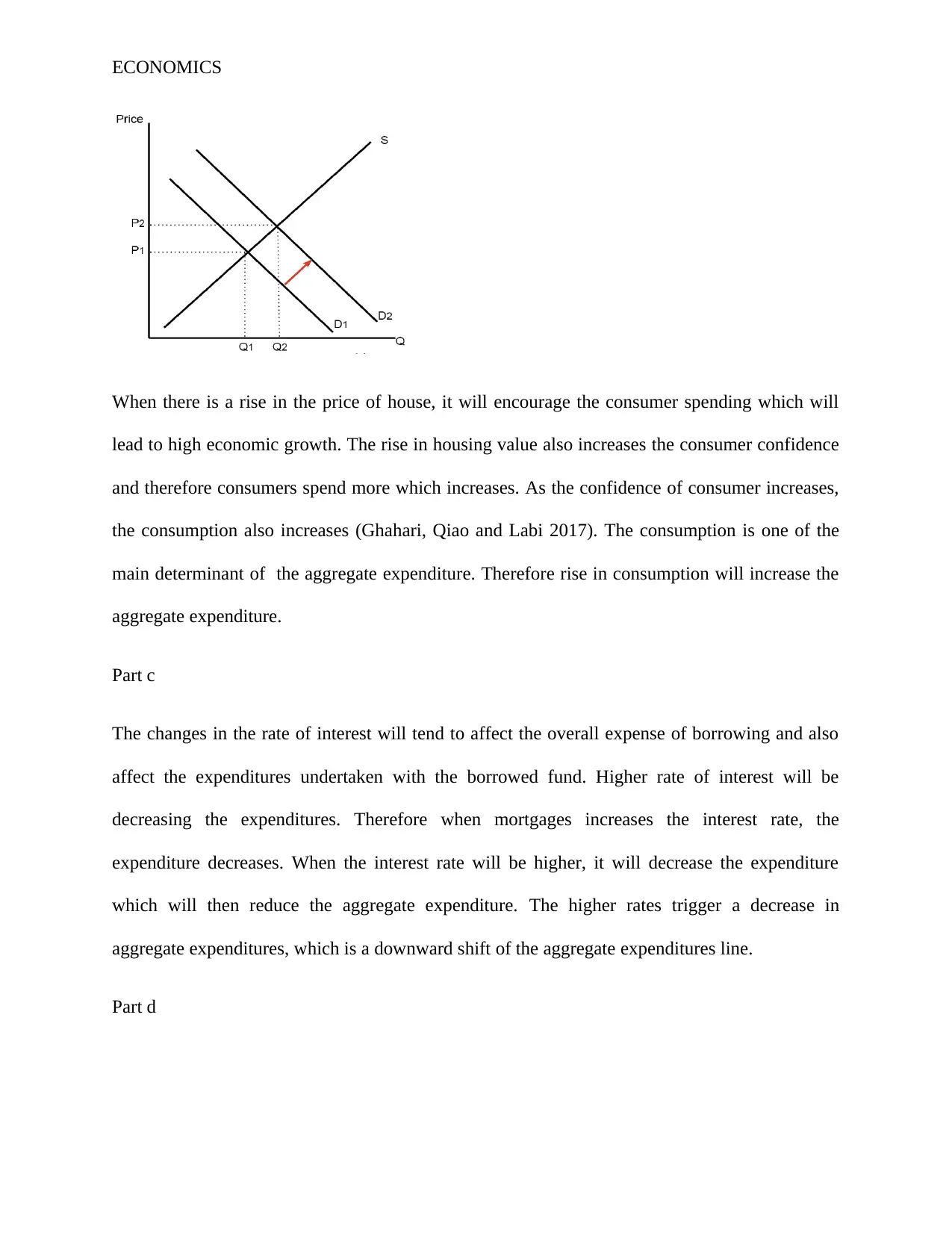
ECONOMICS
When there is a rise in the price of house, it will encourage the consumer spending which will
lead to high economic growth. The rise in housing value also increases the consumer confidence
and therefore consumers spend more which increases. As the confidence of consumer increases,
the consumption also increases (Ghahari, Qiao and Labi 2017). The consumption is one of the
main determinant of the aggregate expenditure. Therefore rise in consumption will increase the
aggregate expenditure.
Part c
The changes in the rate of interest will tend to affect the overall expense of borrowing and also
affect the expenditures undertaken with the borrowed fund. Higher rate of interest will be
decreasing the expenditures. Therefore when mortgages increases the interest rate, the
expenditure decreases. When the interest rate will be higher, it will decrease the expenditure
which will then reduce the aggregate expenditure. The higher rates trigger a decrease in
aggregate expenditures, which is a downward shift of the aggregate expenditures line.
Part d
When there is a rise in the price of house, it will encourage the consumer spending which will
lead to high economic growth. The rise in housing value also increases the consumer confidence
and therefore consumers spend more which increases. As the confidence of consumer increases,
the consumption also increases (Ghahari, Qiao and Labi 2017). The consumption is one of the
main determinant of the aggregate expenditure. Therefore rise in consumption will increase the
aggregate expenditure.
Part c
The changes in the rate of interest will tend to affect the overall expense of borrowing and also
affect the expenditures undertaken with the borrowed fund. Higher rate of interest will be
decreasing the expenditures. Therefore when mortgages increases the interest rate, the
expenditure decreases. When the interest rate will be higher, it will decrease the expenditure
which will then reduce the aggregate expenditure. The higher rates trigger a decrease in
aggregate expenditures, which is a downward shift of the aggregate expenditures line.
Part d
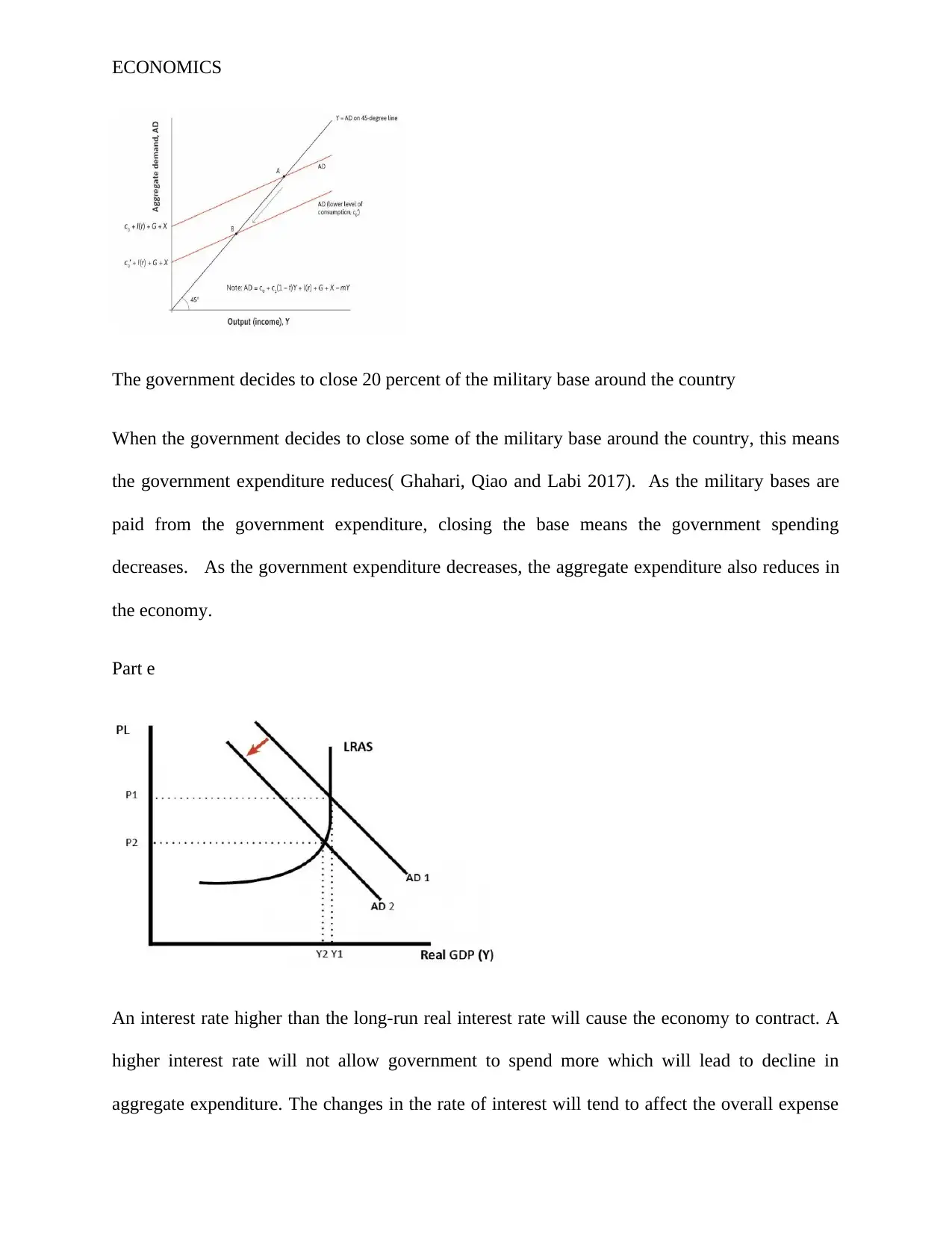
ECONOMICS
The government decides to close 20 percent of the military base around the country
When the government decides to close some of the military base around the country, this means
the government expenditure reduces( Ghahari, Qiao and Labi 2017). As the military bases are
paid from the government expenditure, closing the base means the government spending
decreases. As the government expenditure decreases, the aggregate expenditure also reduces in
the economy.
Part e
An interest rate higher than the long-run real interest rate will cause the economy to contract. A
higher interest rate will not allow government to spend more which will lead to decline in
aggregate expenditure. The changes in the rate of interest will tend to affect the overall expense
The government decides to close 20 percent of the military base around the country
When the government decides to close some of the military base around the country, this means
the government expenditure reduces( Ghahari, Qiao and Labi 2017). As the military bases are
paid from the government expenditure, closing the base means the government spending
decreases. As the government expenditure decreases, the aggregate expenditure also reduces in
the economy.
Part e
An interest rate higher than the long-run real interest rate will cause the economy to contract. A
higher interest rate will not allow government to spend more which will lead to decline in
aggregate expenditure. The changes in the rate of interest will tend to affect the overall expense
⊘ This is a preview!⊘
Do you want full access?
Subscribe today to unlock all pages.

Trusted by 1+ million students worldwide
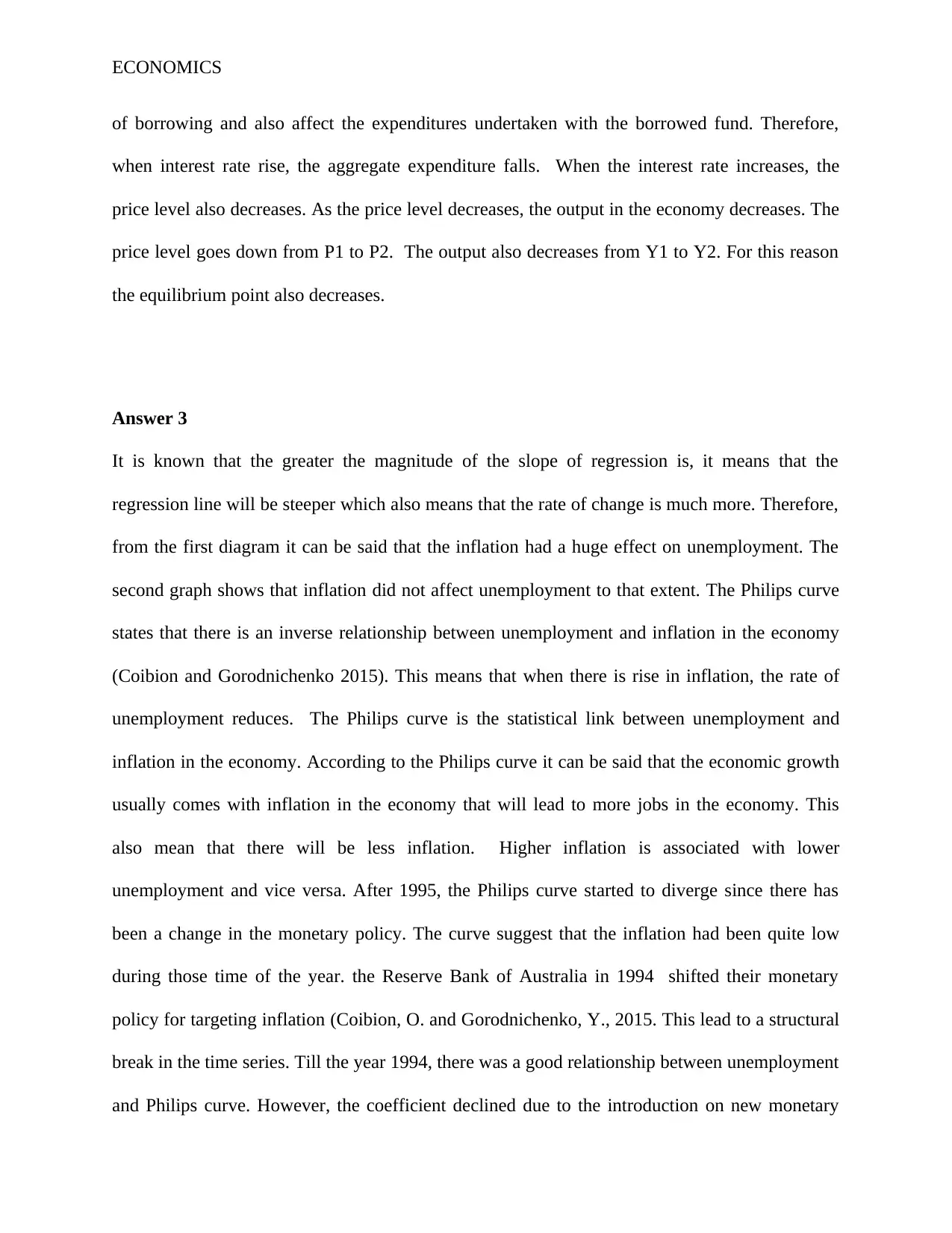
ECONOMICS
of borrowing and also affect the expenditures undertaken with the borrowed fund. Therefore,
when interest rate rise, the aggregate expenditure falls. When the interest rate increases, the
price level also decreases. As the price level decreases, the output in the economy decreases. The
price level goes down from P1 to P2. The output also decreases from Y1 to Y2. For this reason
the equilibrium point also decreases.
Answer 3
It is known that the greater the magnitude of the slope of regression is, it means that the
regression line will be steeper which also means that the rate of change is much more. Therefore,
from the first diagram it can be said that the inflation had a huge effect on unemployment. The
second graph shows that inflation did not affect unemployment to that extent. The Philips curve
states that there is an inverse relationship between unemployment and inflation in the economy
(Coibion and Gorodnichenko 2015). This means that when there is rise in inflation, the rate of
unemployment reduces. The Philips curve is the statistical link between unemployment and
inflation in the economy. According to the Philips curve it can be said that the economic growth
usually comes with inflation in the economy that will lead to more jobs in the economy. This
also mean that there will be less inflation. Higher inflation is associated with lower
unemployment and vice versa. After 1995, the Philips curve started to diverge since there has
been a change in the monetary policy. The curve suggest that the inflation had been quite low
during those time of the year. the Reserve Bank of Australia in 1994 shifted their monetary
policy for targeting inflation (Coibion, O. and Gorodnichenko, Y., 2015. This lead to a structural
break in the time series. Till the year 1994, there was a good relationship between unemployment
and Philips curve. However, the coefficient declined due to the introduction on new monetary
of borrowing and also affect the expenditures undertaken with the borrowed fund. Therefore,
when interest rate rise, the aggregate expenditure falls. When the interest rate increases, the
price level also decreases. As the price level decreases, the output in the economy decreases. The
price level goes down from P1 to P2. The output also decreases from Y1 to Y2. For this reason
the equilibrium point also decreases.
Answer 3
It is known that the greater the magnitude of the slope of regression is, it means that the
regression line will be steeper which also means that the rate of change is much more. Therefore,
from the first diagram it can be said that the inflation had a huge effect on unemployment. The
second graph shows that inflation did not affect unemployment to that extent. The Philips curve
states that there is an inverse relationship between unemployment and inflation in the economy
(Coibion and Gorodnichenko 2015). This means that when there is rise in inflation, the rate of
unemployment reduces. The Philips curve is the statistical link between unemployment and
inflation in the economy. According to the Philips curve it can be said that the economic growth
usually comes with inflation in the economy that will lead to more jobs in the economy. This
also mean that there will be less inflation. Higher inflation is associated with lower
unemployment and vice versa. After 1995, the Philips curve started to diverge since there has
been a change in the monetary policy. The curve suggest that the inflation had been quite low
during those time of the year. the Reserve Bank of Australia in 1994 shifted their monetary
policy for targeting inflation (Coibion, O. and Gorodnichenko, Y., 2015. This lead to a structural
break in the time series. Till the year 1994, there was a good relationship between unemployment
and Philips curve. However, the coefficient declined due to the introduction on new monetary
Paraphrase This Document
Need a fresh take? Get an instant paraphrase of this document with our AI Paraphraser
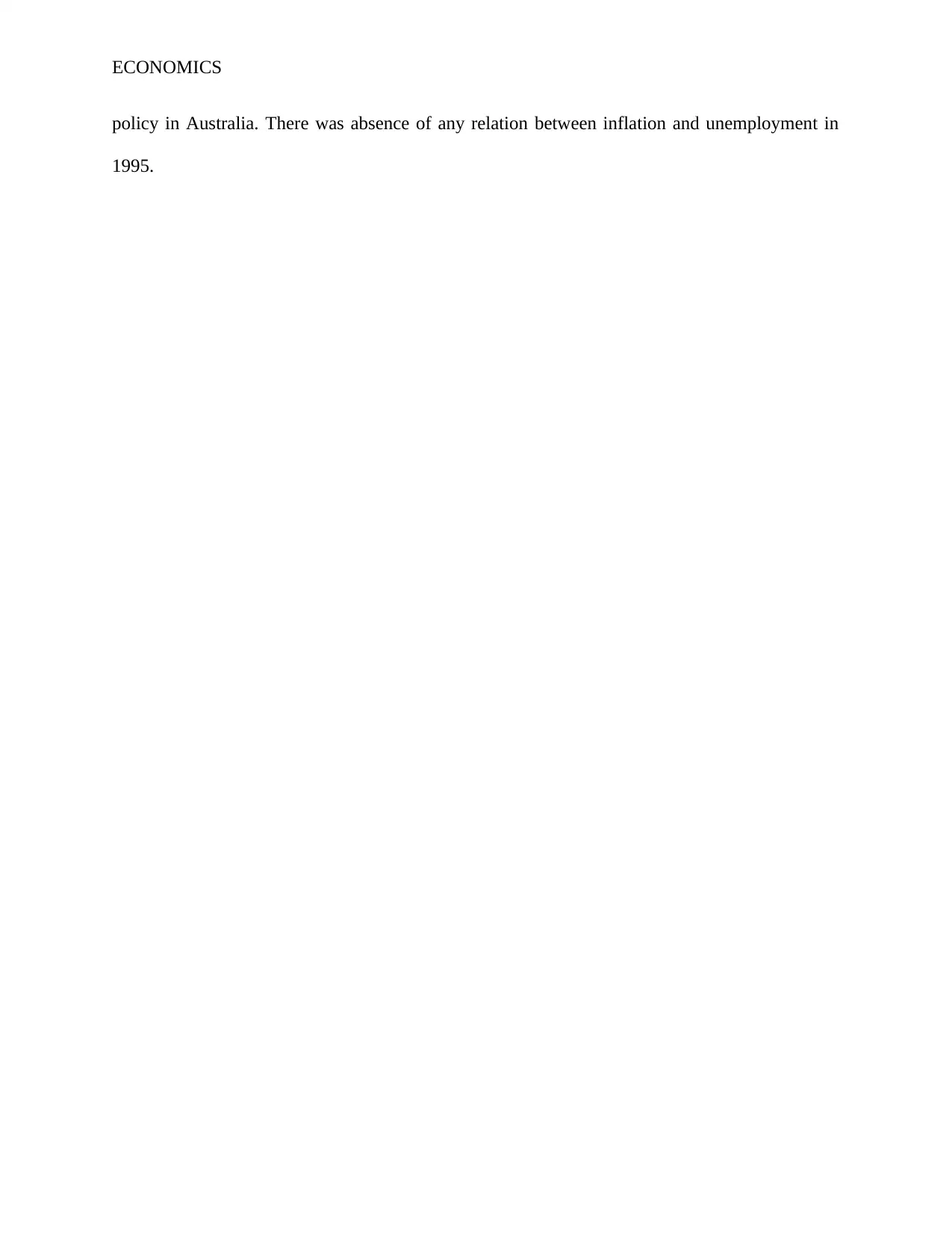
ECONOMICS
policy in Australia. There was absence of any relation between inflation and unemployment in
1995.
policy in Australia. There was absence of any relation between inflation and unemployment in
1995.
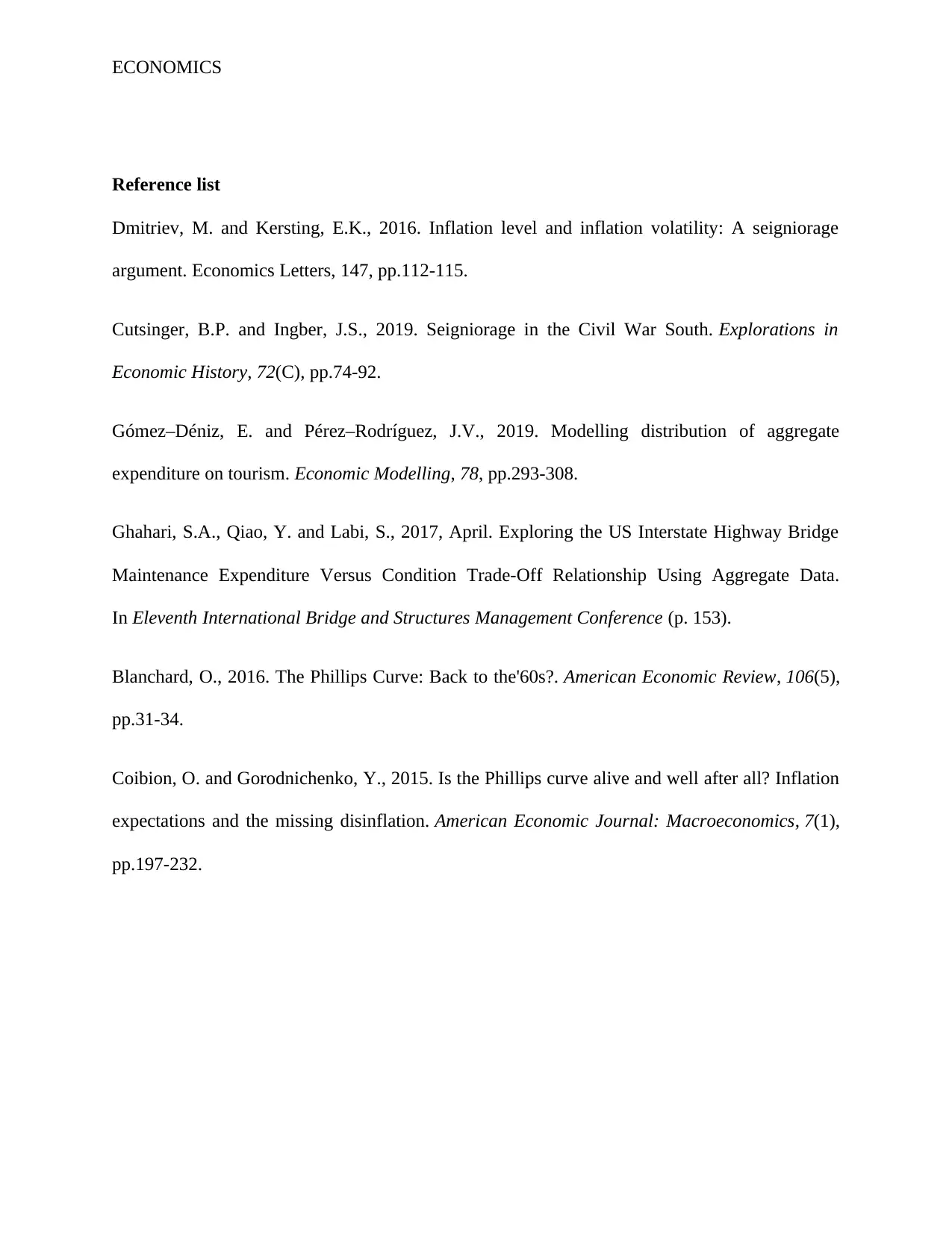
ECONOMICS
Reference list
Dmitriev, M. and Kersting, E.K., 2016. Inflation level and inflation volatility: A seigniorage
argument. Economics Letters, 147, pp.112-115.
Cutsinger, B.P. and Ingber, J.S., 2019. Seigniorage in the Civil War South. Explorations in
Economic History, 72(C), pp.74-92.
Gómez–Déniz, E. and Pérez–Rodríguez, J.V., 2019. Modelling distribution of aggregate
expenditure on tourism. Economic Modelling, 78, pp.293-308.
Ghahari, S.A., Qiao, Y. and Labi, S., 2017, April. Exploring the US Interstate Highway Bridge
Maintenance Expenditure Versus Condition Trade-Off Relationship Using Aggregate Data.
In Eleventh International Bridge and Structures Management Conference (p. 153).
Blanchard, O., 2016. The Phillips Curve: Back to the'60s?. American Economic Review, 106(5),
pp.31-34.
Coibion, O. and Gorodnichenko, Y., 2015. Is the Phillips curve alive and well after all? Inflation
expectations and the missing disinflation. American Economic Journal: Macroeconomics, 7(1),
pp.197-232.
Reference list
Dmitriev, M. and Kersting, E.K., 2016. Inflation level and inflation volatility: A seigniorage
argument. Economics Letters, 147, pp.112-115.
Cutsinger, B.P. and Ingber, J.S., 2019. Seigniorage in the Civil War South. Explorations in
Economic History, 72(C), pp.74-92.
Gómez–Déniz, E. and Pérez–Rodríguez, J.V., 2019. Modelling distribution of aggregate
expenditure on tourism. Economic Modelling, 78, pp.293-308.
Ghahari, S.A., Qiao, Y. and Labi, S., 2017, April. Exploring the US Interstate Highway Bridge
Maintenance Expenditure Versus Condition Trade-Off Relationship Using Aggregate Data.
In Eleventh International Bridge and Structures Management Conference (p. 153).
Blanchard, O., 2016. The Phillips Curve: Back to the'60s?. American Economic Review, 106(5),
pp.31-34.
Coibion, O. and Gorodnichenko, Y., 2015. Is the Phillips curve alive and well after all? Inflation
expectations and the missing disinflation. American Economic Journal: Macroeconomics, 7(1),
pp.197-232.
⊘ This is a preview!⊘
Do you want full access?
Subscribe today to unlock all pages.

Trusted by 1+ million students worldwide
1 out of 9
Related Documents
Your All-in-One AI-Powered Toolkit for Academic Success.
+13062052269
info@desklib.com
Available 24*7 on WhatsApp / Email
![[object Object]](/_next/static/media/star-bottom.7253800d.svg)
Unlock your academic potential
Copyright © 2020–2025 A2Z Services. All Rights Reserved. Developed and managed by ZUCOL.




